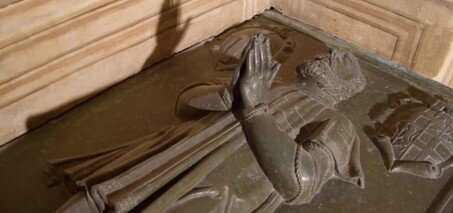Monument - Jean de Valette
Jean Parisot de Valette
Jean de Valette came from noble family from the Gascoigne. His the date of birth is unclear but it must have been 1495 onwards. His date of death is recorded as 21st of August 1568, at Valletta, Malta. He entered the order at a young age in 1514 and never returned to France again.
He spent his working career at the order of St John on Rhodes, Malta, Tripoli and at sea. After the loss of Rhodes in 1523, Jean de Valette travelled with the Order to Malta and arrive there in 1530. His career move forwards 37 he became the governor of the fortification of Tripoli.
When in 1541 he was part of a naval battle against the enemies of the Order, he was wounded and served as a galley slave on board of a Barbary Coast galley commanders by Turgut Reis, a man would play a very important role in the attack of Malta during the Great Siege of 1565. De Valette was ransomed after one year at the rudders and returned to a commanding position within the Order.
In 1554 he became the captain general of the fleet of galleys of the Order and during the Great Sieges he became the shining example of a war hero. Because of his heroism the new city of Valletta was named after him. He is buried in the Grand Masters Crypt at St John's Co-Cathedral in Valletta.
Jean de Valette came from noble family from the Gascoigne. His the date of birth is unclear but it must have been 1495 onwards. His date of death is recorded as 21st of August 1568, at Valletta, Malta. He entered the order at a young age in 1514 and never returned to France again. He spent his working career at the order of St John on Rhodes, Malta, Tripoli and at sea. After the loss of Rhodes in 1523, Jean de Valette travelled with the Order to Malta and arrive there in 1530.
His career move forwards 37 he became the governor of the fortification of Tripoli. When in 1541 he was part of a naval battle against the enemies of the Order, he was wounded and served as a galley slave on board of a Barbary Coast galley commanders by Turgut Reis, a man would play a very important role in the attack of Malta during the Great Siege of 1565.
De Valette was ransomed after one year at the rudders and returned to a commanding position within the Order. In 1554 he became the captain general of the fleet of galleys of the Order and during the Great Sieges he became the shining example of a war hero. Because of his heroism the new city of Valletta was named after him. He is buried in the Grand Masters Crypt at St John's Co-Cathedral in Valletta.
Unfortunately, La Valette has never seen his city completed, because he died in 1568.
Address and street / location can be found on our map, click on Guide in the menu bar and you will get a map with markers. |
Additional information
Statue of the Grandmaster Jean de La Valette on Jean de Valette Square. The statue is 2.5m high and was cast in bronze by the local sculptor Joseph Chetcuti. The statue La Valette is shown armour and holding a sword in one hand and Valletta's plan in the other. The grandmaster looks at the office of the Order of St. John.
Portrait painting.

Painting in memory of the Great Siege.

The first resting place of the Grandmaster Jean Parisot de Valette was first in Church of Our Lady of Victories, now the Grandmaster has a crypt in St. John's Co-Cathedral together with eleven Grandmaster.


This Jean de Valette page is part of “The Malta Magazine”.
This magazine is for every resident and visitor to the country of Malta. But is also educational and for anyone interested in Malta. The Malta Magazine highlights the past and present of specific subjects and/or places of interest with the help of extensive information and photos.
As a tool during your journey of discovery through Malta, you can use our information services free of charge. You can do this in two ways, via our website https://maltaguide.pro or our app depending on your operating system, Google Play or Apple Store. Both give you the same information.
“The Malta magazine” is the best, ultimate and most comprehensive magazine you can get of Malta.
The magazine is growing fast and will soon contain more than 350 interesting topics.
Find and discover interesting sights and discover the many historical secrets of the country Malta. Find all things to do and places of interest in your exploration.
“The Malta magazine” is also convenient whether you are walking, driving a car, or using the hop-on and hop-off bus trip, boat trip, etc.
“The Malta magazine” provides you with general information about the sights, Malta’s beauty, secrets, history and culture, its architecture, fortifications, etcetera and specific information as: what took place here?; When was it built and by whom?; What are the functions of all these.
“The Malta magazine” describes also religious subjects, museums, parks, places of interest, public toilets and much more useful information. Interesting texts set up by local experts and additional informative photos make this app distinctive.
“The Malta magazine” answers many questions and shows in an easy way to navigate way where the sights are located. A great landmap and citymap made specifically for you, is a great tool. You can immediately see where you are and where the sights are.
In this "Malta Magazine" you will find the location, address, opening hours and admission / entrance fee, general additional information and news about the spot.
Everything in “The Malta magazine” is easy to operate, without any knowledge and suitable for young and old.
“The Malta magazine” is free while you normally would pay for a guided tour, you may enjoy navigating through Malta on your own terms.
“The Malta magazine” is constantly maintained about: attractions which are closed due to renovation, changed entrance fees or opening times, etc. This maintenance costs a lot of money. However, it has been decided not to include annoying advertisements. The “The Malta magazine” has no hidden costs.
The skillfielly texts are written by local experts and additional informative photos make “The Malta magazine” information provision distinctive.



